Tarentum › Brundisium » Ancient origins
Articles and Definitions › Contents
- Tarentum › Ancient History
- Brundisium › Antique Origins
Ancient civilizations › Historical and archaeological sites
Tarentum › Ancient History
Definition and Origins
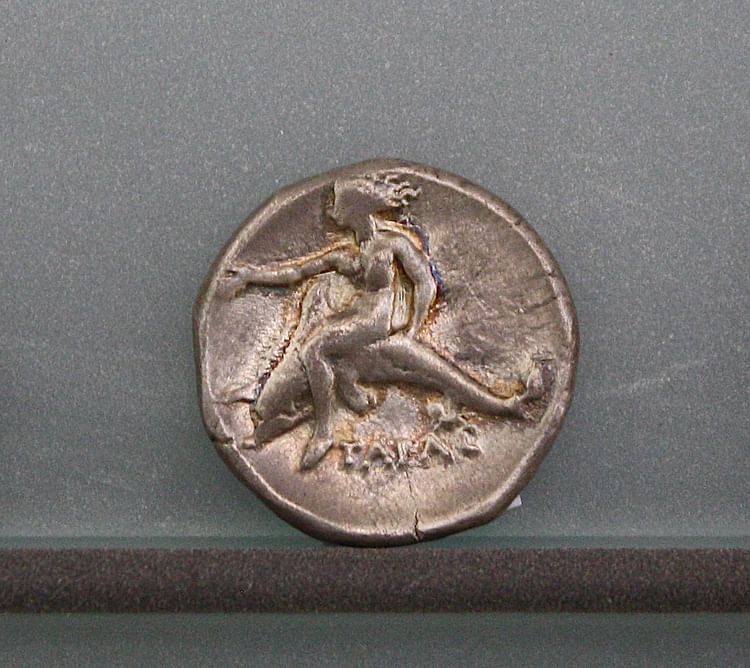
Tarentum (Taras, modern Taranto), located on the southern coast of Apulia, Italy, was a Greek and then Roman city.Controlling a large area of Magna Graecia and heading the Italiote League, Tarentum, with its excellent harbour, was a strategically significant city throughout antiquity. Thus, it would play a pivotal role in the wars between Pyrrhus and Rome in the 3rd century BCE and again during the Second Punic War when Hannibal occupied southern Italy. While little remains today of ancient Tarentum's buildings, the city's museum boasts one of the largest collections of Greek pottery in the world and has many fine bronzes, gold jewellery and floor mosaics.
HISTORICAL OVERVIEW
Foundation
Tarentum, or Taras as it was first known in Greek, was a colony founded by Sparta in the 8th century BCE as part of the wave of Greek colonization of the region which would become known as Magna Graecia. According to tradition the city was founded in 706 BCE by the Spartan hero Phalanthus. The first colonists were also said to be the offspring of Spartan women and helots, the semi-enslaved agricultural workers who served their Spartan masters. Archaeological evidence, though, points to a much earlier Neolithic settlement followed by a Mycenaean presence in the area during the Bronze Age.
GOODS & COINAGE FROM TARENTUM HAVE BEEN EXCAVATED ALL ALONG THE SOUTHERN & ADRIATIC COASTS OF ITALY.
A Thriving City
Located on the coast and with the best harbour in the gulf of Tarentum, the city would prosper and become one of the most important commercial centres in the region. The growth of the city did bring it into conflict with local rivals such as Metapontum at the other end of the gulf, but Tarentum won important victories over local tribes (the Messapians and Peucetians) in 490 and 480 BCE. These battles were commemorated in dedications made at Delphi, although peace did not last long as the Messapians inflicted a serious defeat on Tarentum c. 475 BCE in a battle described by Herodotus as a 'great bloodbath' (7.170.3). A consequence of the city's military weakness was an overthrow of the ruling class, which was replaced by a system of limited democracy.
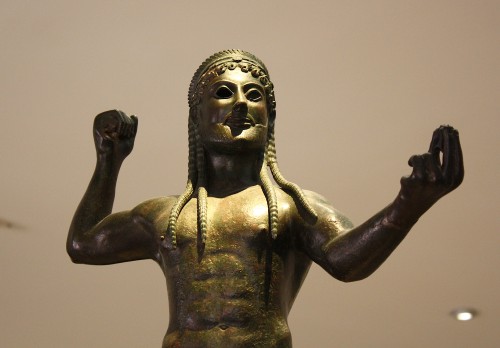
Bronze Zeus, Tarentum
Tarentum's fortunes improved by the end of the 5th century BCE and saw the city grow to some 530 hectares and increase its outlying territory, an expansion aided by the decline of long-time rival Croton further down the coast of southern Italy. Goods and coinage from Tarentum (including silver staters with their distinctive male figure riding a dolphin) have been excavated all along the southern and Adriatic coasts of Italy illustrating the city's prosperity and trading capacity. Large temple sanctuaries and cemeteries also attest to the growth of the city during the latter half of the 5th century BCE. The city even founded its own colony to the west, Heraclea (Herakleia), in 433 BCE. Around 400 BCE Heraclea became the seat of the Italiote League, an association of southern Italian city-states, which was dominated by Tarentum.
During the 4th century BCE Tarentum government was dominated by Pythagorean thought ( Pythagoras had established his school further down the coast) and one man, in particular, Archytas (c. 400-350 BCE). The celebrated mathematician, Pythagorean and statesman was elected general seven times and probably forged an alliance with Syracuse, the powerful city-state in Sicily, which allowed Tarentum to expand further at a time when Dionysius I, the tyrant of Syracuse, was busy sacking cities in southern Italy. In the latter half of the 4th century BCE Tarentum fought to maintain its position of regional dominance and face the ever-rising threat of the Messapians and Lucanians by hiring mercenary armies, often led by generals from Sparta and Epirus. By the 3rd century BCE, though, a much more dangerous enemy was on the prowl in Magna Graecia: Rome.
Pyrrhus & Rome
Fortunately for Tarentum a powerful ally was on hand to save them from Roman occupation. The great general and king of Epirus, Pyrrhus, responded to a call for help from the city when it was under imminent Roman attack in 280 BCE. Pyrrhus crossed the Adriatic with his army of 25,000 infantry and, employing 20 war elephants and a superior cavalry force of 3,000, he won battles against Roman armies at Heraclea in 280 BCE and Ausculum in 279 BCE. The victories, nevertheless, came at a high cost in lives on both sides and these battles were not decisive, hence the lasting expression 'a Pyrrhic victory'. More importantly for Tarentum, Pyrrhus was soon forced to leave the region and meet the increasing threat from Carthage to his interests in Sicily. With the field now clear, Rome occupied the city in 270 BCE and thereafter Tarentum became an ally of the peninsula's dominant power.

Pyrrhic War
Hannibal & Rome
The region once more became the most important battlefield in the Mediterranean when Hannibal invaded Italy in the Second Punic War (218-201 BCE). Tarentum, like most of the southern Italian cities, sided with Carthage but the acropolis and harbour of Tarentum were, nevertheless, occupied by Rome. Hannibal desperately sought a port from which his army could be resupplied from Africa but he could not take Tarentum and managed only to occupy the outer town.
During the chaos of the Punic Wars a brief attempt was made at regaining the city's independence in 213 BCE when a number of aristocrats overthrew the government. It was a short-lived rebellion and the city once again came fully under Roman control in 209 BCE when it was captured by Quintus Fabius Maximus. When Scipio Africanus sailed to Africa and attacked Carthage itself in 203 BCE, Hannibal was recalled from Italy for a last-ditch defence of the homeland. Tarentum was left at the mercy of Rome. With its lands greatly reduced and governed directly by a Roman praetor, the city eventually regained its former status as a formal ally c. 180 BCE. With the extension of the via Appia to Brundisium further to the south-east, Tarentum lost its position as the primary port in southern Italy.

Archaic Columns, Tarentum
Tarentum trundled on as a modest town in the Roman Republic and in 122 BCE the colony of Neptunia was founded which would become part of Tarentum proper in 89 BCE. In 59 BCE plots of Tarentum land were given to veterans and the city became ever more Romanised. The city still produced products for export such as wool, textiles, Tyrian purple dye, and foodstuffs. Epigraphic evidence, the density of private housing and presence of several large villas demonstrate that the city remained economically active and relatively prosperous well into the imperial period with Emperor Nero (r. 54-68 CE) granting it colony status.
Late Antiquity
Both Jews and Christians were a strong presence in Tarentum from the 1st century CE onwards with a bishopric established by the 4th century CE or earlier. During the Gothic invasions the town was, notwithstanding its new fortifications, occupied by Totila, king of the Ostrogoths (r. 541-552 CE). The city's excellent harbour never ceased to attract a naval presence when the opportunity arose and Constans II, the Byzantine emperor, sent a fleet to Italy which landed at Tarentum in 661 CE. In 668 CE Tarentum, still, as ever, a strategically useful acquisition for invaders, entered the medieval period with a bang when the Lombard duke Romauld sacked the city.
ARCHAEOLOGICAL REMAINS
Tarentum once had large sacred complexes with impressive temples but due to the fact that the city has been continuously occupied since antiquity most of the large scale ancient architecture has long since been dismantled and reused elsewhere in more modern buildings. An exception are the two massive columns once belonging to an archaic temple dedicated to Poseidon. These columns now stand in the corner of the municipal square (not their original location) and their massive size hints at the enormity of this now lost temple.

Gold Boat Earring, Tarentum
What Tarentum may lack in architecture is more than compensated for in the richness of the artefacts excavated at the site, the surrounding countryside, and the harbour itself. Many of the finest and best-preserved examples of black-figure potteryand red figure pottery have been discovered at the site with Taranto's magnificent MARTA museum possessing a collection which rivals that of Athens and the Vatican in scope and artistry. Gold jewellery in the form of diadems, rings, earrings and necklaces with minute and elaborate filigree and granulation decoration are another rich source of evidence which points to the skill of Tarentum's metal workers and the wealth of the city in the 4th-3rd century BCE. Many of the artefacts are from tombs and none is more interesting than the Tomb of the Athlete, a tomb of a Tarentum victor at the Olympic Games complete with his discus, weights, and javelin heads and, touchingly, the prize he famously won in life, the black-figure amphora given to all winners.
Special mention should be made of the many fine floor mosaics from the city's grander Roman residences. The largest and best preserved is a late-2nd or early 3rd century CE mosaic with four main panels depicting an abduction of a nymph and additional scenes of a leopard, lion and tiger hunting. Smaller side panels show birds and fruit.

Geometrical Mosaic, Tarentum
Another splendid floor mosaic has purely geometrical and floral shapes with a large central circle whose folded velarium(curtain) is given an almost three-dimensional quality by the use of variously shaded tesserae pieces. This perfectly square mosaic dates to the 2nd century CE and belonged to a Roman house or domus in central Tarentum.
Finally, one of the star pieces from ancient Taranto and one which welcomes visitors to the archaeological museum is a bronze statue of Zeus. Dating to c. 530 BCE, the figure once held a thunderbolt in one hand and an eagle in the other. The statue was originally placed on a marble Doric capital and stood in a sanctuary in the city dedicated to the head of the Olympian gods, a potent reminder of the Greek origins of one of southern Italy's wealthiest and most influential ancient cities.
Brundisium › Antique Origins
Definition and Origins
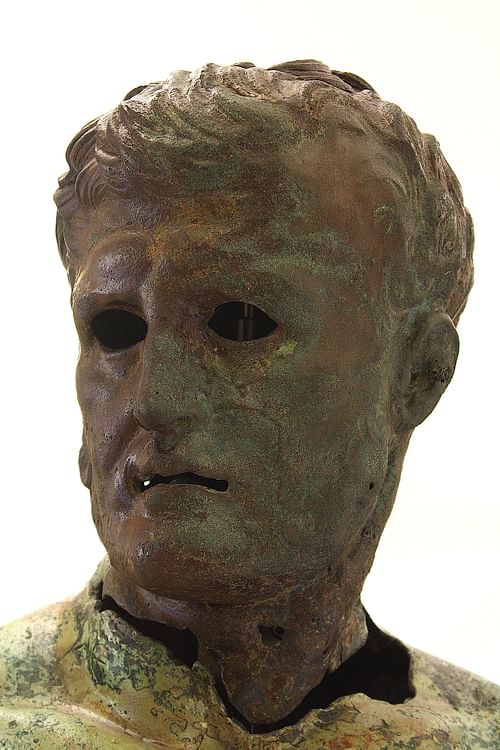
Brundisium (modern Brindisi), located on the Adriatic coast of southern Italy, was a Messapian and then Roman town of great strategic importance throughout antiquity. Although architectural remains are sparse, the city has several claims to fame.Brundisium is the end of the road for the Appian Way, was a traditional launching point for armies and travellers to the East, and played a pivotal role in both the Punic wars and Roman civil wars. Amongst its more impressive artefacts are many examples of Hellenistic and Roman bronze statuary which have been rescued from the town's harbour.
EARLY SETTLEMENT
The area of Brindisi was inhabited in Palaeolithic times some 12,000 years ago and the site of Torre Testa just 7 km to the north was the most important settlement in the region at that time. Thousands of stone tools and other artefacts have been discovered which belonged to the hunter-gatherers of the period. A continued presence in the Neolithic period and Bronze Age is attested by additional finds.
MESSAPIAN & GREEK TOWN
Located at the very bottom of the Italian peninsula, in local mythology Brundisium was first settled by either Diomedes, a hero of the Trojan War, or Phalanthus, the Spartan who was also credited with founding nearby Tarentum (modern Taranto). Yet other sources suggest Brundisium was founded by settlers from Crete. Certainly, a Greek influence, if not actually full colonization, is indicated in the cemetery at Tor Pisani. Little is known today regarding the town when it was inhabited by the Messapians, one of the tribes who lived in the 'heel' of Italy which constitutes modern Apulia. Their name for the town was Brentesion which may derive from the Messapian brentos, meaning 'dear's head', which describes the form of the harbour with its two distinctive promontories.
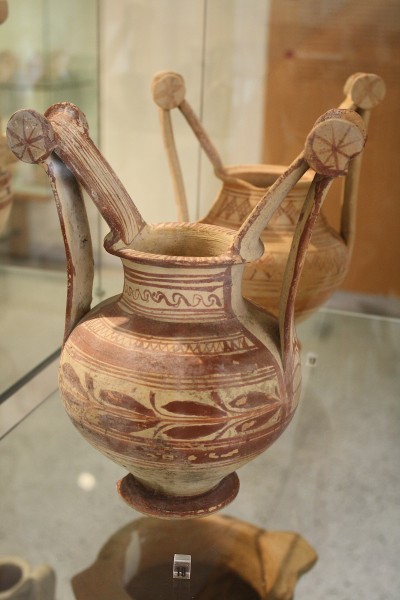
Two-handled Vase, Brundisium
The best surviving examples of Messapian culture are ceramics. In particular, the high-handled amphorae known as trozella are unique to the region and have geometrical and plant motif decorative designs. There is evidence of a long and bitter rivalry with Tarentum (modern Taranto), the Spartan colony some 75 kilometres to the west on Italy's southern coast. Brundusium minted its own coinage and formed an alliance with Thurii c. 440 BCE, another Greek colony to the west built on the site of old Sybaris.
ROMAN BRUNDISIUM
Brundisium started to take on a greater regional significance only from the 3rd century BCE onwards when Rome began to expand throughout the Italian peninsula. The Romans conquered the city in 266 BCE and a colony was formally established at Brundisium in 247 or 244 BCE. The city was then fortified in order to ensure the Romans kept hold of the excellent double harbour they had acquired. Around the same time the great Roman road the Via Appia (Appian Way) was extended to reach the city, connecting it with Rome itself and bringing its total paved length to 569 km or 385 Roman miles. Brundisium consequently became the main point of departure for anyone travelling to Greece and the East and usurped Tarentum's position as the most important port in the south. Today a 19.2 m tall single marble column stands near the waterfront which was traditionally thought to mark the spot where the road finally ends. In fact, inscriptions reveal that the column once belonged to a building with a religious or commemorative function connected to the sea.

End of the Appian Way Column Marker
During the First Punic War (264-241 BCE) the Carthaginian general Hamilcar Barca had attacked several Roman coastal cities in search of booty for his mercenaries and one of them was Brundisium in 247 BCE. These skirmishes, though, were largely a minor distraction from the main battlefront in Sicily. The city became more directly embroiled in the Second Punic War (218-201 BCE) when Hannibal invaded Italy and encamped in the southern corner of the peninsula. The Carthaginian general desperately needed a port through which he could receive reinforcements and supplies from Africa but the Romans successfully blockaded the harbours of the southern coast.
IN THE CIVIL WAR OF THE 1ST CENTURY BCE BRUNDISIUM WOULD, ONCE AGAIN, FIND ITSELF CENTRE STAGE IN THE THEATRE OF A BLOODY & BRUTAL WAR.
Sulla gave Brundusium an exemption from the portoria, the tax duty imposed on the import and export of goods at ports, and the town was given municipium status around 89 BCE which granted its citizens Roman citizenship. However, the city's fortunes would soon suffer a dramatic downturn during the violent final stages of the Roman Republic. In the civil war of the 1st century BCE Brundisium would, once again, find itself centre stage in the theatre of a bloody and brutal war. Julius Caesarcaptured the city in 49 BCE so that he could prevent his great rival Pompey from fleeing Italy. Then it was attacked again in 40 BCE, this time by Mark Antony. The city's handy location at the foot of Italy was proving something of a liability for the local residents. Brundisium was also the site of the accord, known as the Treaty of Brundisium, between Antony and Octavian to carve up the Roman empire between themselves. When Octavian won the war and became Emperor Augustus, a triumphal arch was set up in the city in his honour.
Yet another historical event linked to the city is the death of Virgil there in 19 BCE shortly after the writer returned from a trip to Greece. The city would continue to exist as a minor Roman town in the imperial period with the slave trade, fishing and shipbuilding providing plenty of employment and wealth for some as evidenced in the large villas of the period. A Christian community was founded by Saint Leucius of Alexandria in the second half of the 2nd century CE.
Unfortunately, the continual inhabitation of the site and constant re-use of ancient building materials has obscured its development in later times and left few standing remains. Excavations have revealed traces of all the usual features one would expect to find in a Roman town: a forum, market square, Roman baths, aqueducts, amphitheatre, necropolis and regular town plan. There was also an armamentarium or arsenal and several warehouses, both indicative of Brundisium's primary function as a gateway to Roman Italy for goods and troops.
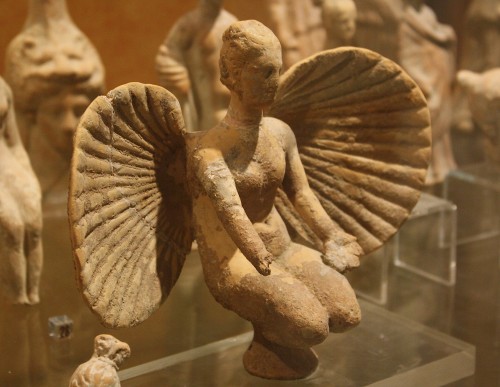
Terracotta Aphrodite, Brundisium
ARTEFACTS
While little remains of the ancient buildings of Brundisium, the city, and especially its harbour, has provided some outstanding examples of Greek and Roman art for posterity. Amongst these survivors are many bronze statues. Unfortunately, most are incomplete but some of them remain sufficiently intact to still instil awe at the skills of ancient metalworkers. A notable piece is the head and torso of a figure known as the Hellenistic Prince which dates to the 2nd or 1st century BCE. Another fine head has been identified as a Greek philosopher, possibly Antisthenes, and dates to the 4th century BCE. Besides many examples of trozella already mentioned, the town's archaeological museum possesses a fine collection of Greek pottery and terracotta figurines including a charming depiction of a crouched Aphrodite emerging from her shell.
LICENSE:
Article based on information obtained from these sources:with permission from the Website Ancient History Encyclopedia
Content is available under License Creative Commons: Attribution-NonCommercial-ShareAlike 3.0 Unported. CC-BY-NC-SA License